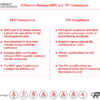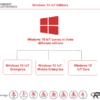Dear Readers,
In this blog we are going to learn about, The Wiegand interface, stemming from the 1980s popularity of Wiegand effect card readers, has become a de facto wiring standard for connecting card swipe mechanisms to access control systems. This interface employs three wires, including a common ground and two data transmission wires, typically labeled DATA0 and DATA1. It relies on voltage levels to encode data, with a high voltage representing idle or “1” state and a low voltage indicating a “0.” What distinguishes Wiegand is its ability to accommodate long cable runs, up to 500 feet, making it ideal for secure access systems. The associated communications protocol, known as the Wiegand protocol, originally featured 26 bits of data, though variations and extensions have been introduced by different manufacturers to address the limitations of the original format, enabling its widespread adoption in access control applications with cards carrying fewer than 37 filaments.
The Wiegand interface is a de facto wiring standard which arose from the popularity of Wiegand effect card readers in the 1980s. It is commonly used to connect a card swipe mechanism to the rest of an access control system. The sensor in such a system is often a “Wiegand wire”, based on the Wiegand effect, discovered by John R. Wiegand. A Wiegand-compatible reader is normally connected to a Wiegand-compatible security panel.
Physical layer The Wiegand interface uses three wires, one of which is a common ground and two of which are data transmission wires usually called DATA0 and DATA1, alternatively labeled “D0” and “D1” or “Data Low” and “Data High”. When no data is being sent, both DATA0 and DATA1 are pulled up to the “high” voltage level — usually +5 VDC. When a 0 is sent the DATA0 wire is pulled to a low voltage while the DATA1 wire stays at a high voltage. When a 1 is sent the DATA1 wire is pulled to a low voltage while DATA0 stays at a high voltage.
The high signaling level of 5 VDC is used to accommodate long cable runs from card readers to the associated access control panel, typically located in a secure closet. Most card reader manufacturers publish a maximum cable run of 500 feet (150 m). An advantage of the Wiegand signalling format is that it allows very long cable runs, far longer than other interface standards of its day allowed.
Protocol The communications protocol used on a Wiegand interface is known as the Wiegand protocol. The original Wiegand format had one parity bit, 8 bits of facility code, 16 bits of ID code, and a trailing parity bit for a total of 26 bits. The first parity bit is calculated from the first 12 bits of the code and the trailing parity bit from the last 12 bits. However, many inconsistent implementations and extensions to the basic format exist.
Many access control system manufacturers adopted Wiegand technology, but were unhappy with the limitations of only 8 bits for site codes (0-255) and 16 bits for card numbers (0-65535), so they designed their own formats with varying complexity of field numbers and lengths and parity checking.
The physical size limitations of the card dictated that a maximum of 37 Wiegand wire filaments could be placed in a standard credit card, as dictated by CR80 or ISO/IEC 7810 standards, before misreads would affect reliability. Therefore, most Wiegand formats used in physical access control are less than 37 bits in length.
About Ambimat Electronics:
With design experience of close to 4 decades of excellence, world-class talent, and innovative breakthroughs, Ambimat Electronics is a single-stop solution enabler to Leading PSUs, private sector companies, and start-ups to deliver design capabilities and develop manufacturing capabilities in various industries and markets. AmbiIoT design services have helped develop Smartwatches, Smart homes, Medicals, Robotics, Retail, Pubs and brewery, Security.
Ambimat Electronics has come a long way to become one of India’s leading IoT(Internet of things) product designers and manufacturers today. We present below some of our solutions that can be implemented and parameterized according to specific business needs. AmbiPay, AmbiPower, AmbiCon, AmbiSecure, AmbiSense, AmbiAutomation.
To know more about us or what Ambimat does, we invite you to follow us on LinkedIn or visit our website.




